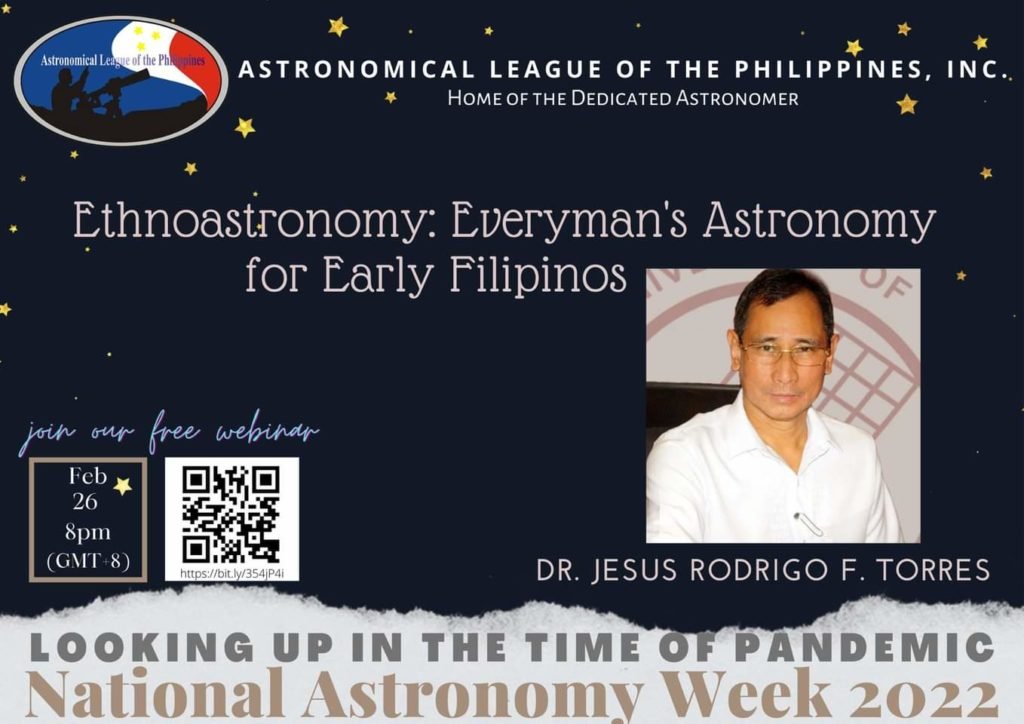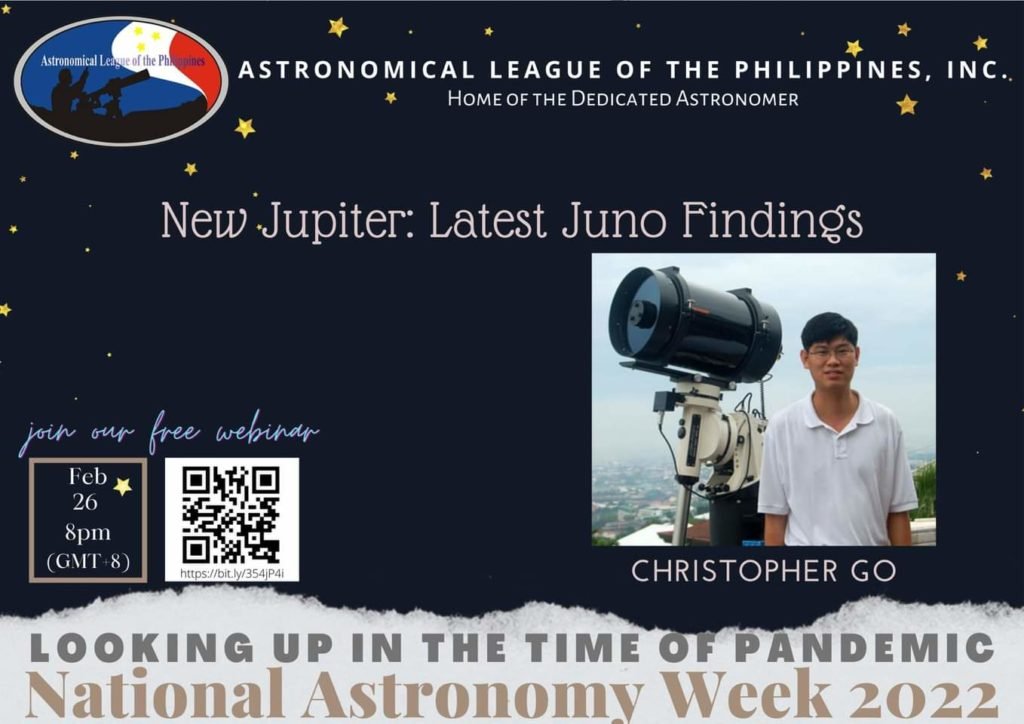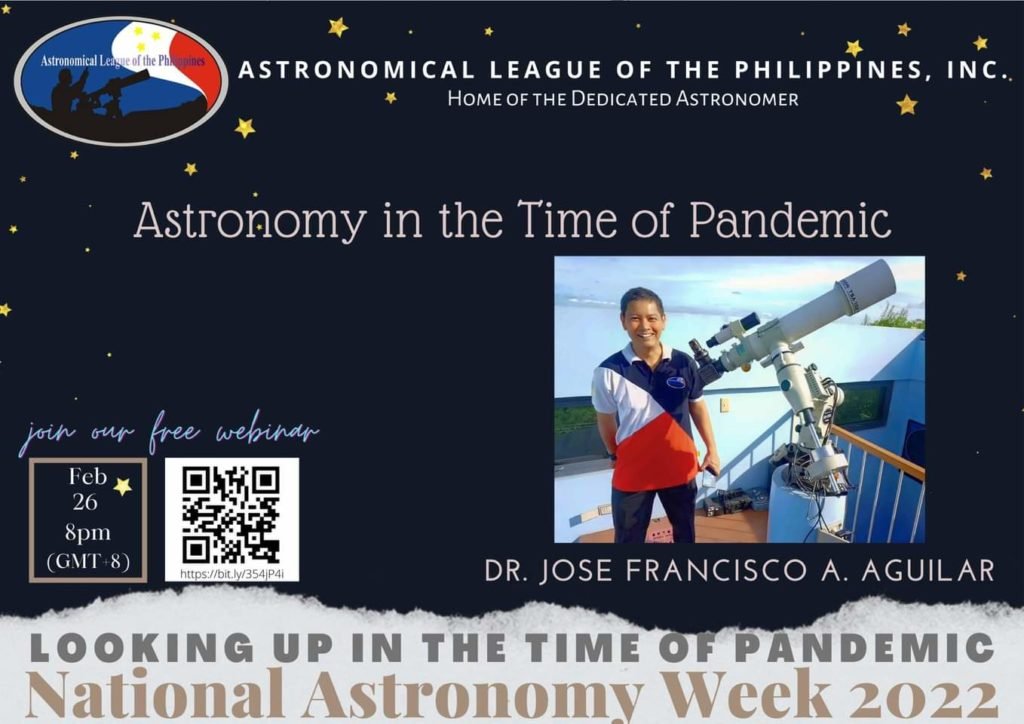
Last February 22nd, Astronomical League of the Philippines (ALP) celebrated National Astronomy Week 2022 with its 1st Astronomy Webinar. Several speakers were lined up for the event to celebrate the event and are as follows:
Ethnoastronomy : Everyman’s Astronomy For Early Filipinos by Dr. Jesus Rodrigo F. Torres
New Jupiter: Latest Juno Findings by Christopher Y. Go
Astronomy In The Time Of The Pandemic by Dr. Jose Francisco A. Aguilar
From The Earth, To The Stars, and Back: Our Personal Journey by Imelda B. Joson and Edwin L. Aguirre
Mobile Phone Astrophotography by Peter Benedict O. Tubalinal
The event started at 8:00pm PST with Host Andrew Ian Chan welcoming everyone to the Astro Webinar. The singing of the Philippine National Anthem and Prayer invocation followed. Afterwards, he also touched on the rules of the webinar as well as invite the attendees to participate in the QnA portion after the end of each talk.
ALP President James Kevin Ty then proceeded to present a short welcome remark and state the reason for making ALP’s 1st Astro Webinar in lieu of the normal free telescope viewing that are regular made in parks and malls. But since the onset of the COVID-19 pandemic starting last March 2020, ALP as well as other astronomy societies a d club are forced to do virtual stargazing a d as well zoom webinars in place of physical telescope viewing. He also shared his view on when was the 1st real National Astronomy Week started which was spearheaded by Edwin L. Aguirre and Imelda B. Joson way back in 1990 and President Corazon C Aquino proclaim it with Proclamation 544 declaring April 16 to 22, 1990 as National Astronomy Week. The annual event has to be proclaim every year and it was only until 1993 that Francisco Lao, Jr, then president of Philippine Astronomical Society, that he spearheaded it once again to make the National Astronomy Week as a yearly event and held on every 2nd week of February and this was officially proclaimed by President Fidel V. Ramos through Proclamation 130. So overall, National Astronomy Week will be celebrating its 31st year (1991 was not celebrated) and 29th if starting from President Ramos proclamation in 1993.
This was followed by a short 8 minute video showing ALP NAW yearly celebration since 2003.

Afterwards, Dr. Jesus Rodrigo F. Torres gave a very interesting lecture on Philippine Ethnoastronomy. He also was able to share his official English translation with Dr. Dela Cruz of Dante Ambrosio’s book, Balatik. He discussed in layman’s term how our ancient ancestor fascination of the stars as well as create their own constellations and asterisms and use the stars also for navigation.
Afterwards, QnA was open for attendees to ask the speaker and then Dr. Jesus Rodrigo F. Torres was awarded a virtual certificate of appreciation for his interesting talk.

Then ALPer Christopher Go presented the next lecture entitled New Jupiter: Latest Juno Findings. He discussed the latest Jupiter data taken by the Juno spacecraft as well as latest updates on the giant gas planet Jupiter.
After his talk, QnA was open for attendees to ask the speaker and then Christopher Go was awarded a virtual certificate of appreciation for his interesting talk.

This was followed by another interesting talk by ALP VP Jose Francisco “Jett” Aguilar entitled Astronomy In The Time Of The Pandemic. Jett touched on how the current Covid 19 pandemic which started in March 2020 had affected our way of life as well as astronomy in the Philippines. Astronomy was mostly affected as hands on astronomy to promote the hobby like doing public telescope viewing as well as actual astronomy talks and meetings were forbidden to lessen the spread of the virus. It was also at this time that zoom meetings and webinars became the norm for all amateur astronomers not only here but also the rest of the world, in promoting a safe alternative to promote it. With the public restrictions, amateur astronomers had to do astronomical observational and imaging at their own house or backyard on their own to satisfy their astro urges.
After his talk, QnA was open for attendees to ask the speaker and then Dr Jose Francisco Aguilar was awarded a virtual certificate of appreciation for his interesting talk.
Then a 10 minutes break follows with ALP sharing ALPers astro imagers in action with their beautiful astrophotos.

Imelda Joson and Edwin Aguirre was next to share their experience entitled From The Earth, To The Stars, and Back: Our Personal Journey by Imelda B. Joson and Edwin L. Aguirre.
Imelda started her journey discussing our star, the Sun and slowly touching on each of the 8 planets as well as comets, asteroids, dwarf planets and further going out of the solar system towards the discovered exoplanets the nebula, stra clusters, galaxies and then head back again to our mother planet Earth where she shares also her love and protection our mother planets particularly birds, eagles, butterflies and so forth.
After his talk, QnA was open for attendees to ask the speaker and then Imelda Joson and Edwin Aguirre were awarded a virtual certificate of appreciation for their interesting talk.

Last but not the least, Peter Benedict Tubalinal share to the attendees his expert knowledge on how to use a smartphone to doing astrophotography entitled Mobile Phone Astrophotography. He shares how he was able to use his smartphone with his telescopes and binoculars to image the Moon, Sun and bright deep sky objects.
QnA was open for attendees to ask the speaker and Peter Benedict Tubalinal was awarded a virtual certificate of appreciation for their interesting talk.
ALP host and Emcee Andrew Ian Chan then made the closing remark by thanking all the attendees both in Zoom as well as FB live. The event ended with a group shot of the speakers together with ALP event organizers. Congratulations for a very successful astro webinar event in celebration of National Astronomy Week 2022!














